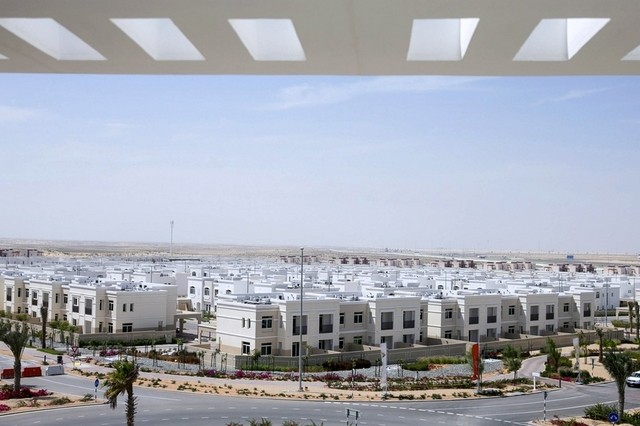
Out in the desert 45 minutes’ drive from Abu Dhabi city centre and 25 minutes from Dubai, Aldar’s Alghadeer community stands as a testimony to the capital’s rising rents.
The new community of just over 2,000 newly built, identical white villas and apartments stand in rows surrounded by greenery and pools.
“Alghadeer is great and has plenty of advantages but there are disadvantages too,” says Tomas, an IT worker who has been living in Alghadeer since March 2014 after moving there with his family from Dubai.
“Until March this year when they opened a Baqala there were no shops here so you had to drive to the petrol station on the 311 to get any groceries or all the way to Dubai Investment Park.”
Not only does Alghadeer lack shops, it is also a long drive to local schools and most residents face a long commute to work. If you do not own a car then you might as well forget about living there as there are no buses and the chances of a taxi coming all the way out there are slim.
But residents say the inconveniences are more than made up for by the relatively affordable cost of living. According to Dubizzle, rents for a two-bedroom apartment go for about Dh80,000 a year whereas in Abu Dhabi a similar sized flat would cost around Dh120,000.
And the development’s location in the emirate of Abu Dhabi yet close to Dubai means that Abu Dhabi Government workers living there are still entitled to housing allowances.
Mr Tomas and his neighbours are just a few examples of the thousands of expatriate residents forced further and further out of both Abu Dhabi and Dubai by steep rents, relocating to places such as Al Ain, Sharjah and Ajman.
According to a report in September by the property broker CBRE, average monthly rents in Abu Dhabi are the second-most expensive in the world, exceeded only by those in London.
It found that average monthly rents in Abu Dhabi now stand at US$2,649, while in Dubai, which came sixth in a global poll reached $2,317.
London was revealed as the most expensive city in which to lease a home with monthly rents of $3,245, while Singapore, Los Angeles and New York claimed third, fourth and fifth spots, respectively.
In Abu Dhabi, which in November 2013 removed a rule restricting rent rises for existing tenants to just 5 per cent, tenants also saw the second-highest rent rises in the world over the past year, with increases in almost every area, according to Better Homes.
With rent rises far outstripping wage increases, anecdotal stories of expatriate families choosing to pack up altogether and leave the country also abound.
The prospect of a city where many middle-income workers who perform some of the capital’s most important functions can no longer afford to live is starting to worry government officials. As such the Abu Dhabi Government is planning to follow in the footsteps of a number of other highly priced cities and introduce affordable housing targets for developers.
In October, the Abu Dhabi Urban Planning Council (UPC) director general Falah Al Ahbabi told The National that new affordable housing requirements could be introduced before the year-end.
“I can tell you [it will be] very soon … within a month, hopefully. Because it’s done,” he said.
The new policy will place targets for developers to achieve 20 per cent of affordable homes within new housing schemes Mr Al Ahbabi said.
“It touches every single detail in affordable housing. Everyone loves it, even the developers,” he said.
However, the UPC has yet to make clear exactly what it classifies as “affordable housing” and who would be eligible to live in it. It has also yet to say whether developers will be offered any incentive for building this sort of housing or whether any device will be put in place to keep rents low once the building has been let.
In the United Kingdom, until recently, developers were required to sell a proportion of the houses in each scheme at cost price to public bodies or housing associations who would then let them out to low earners placed on council waiting lists at 50 per cent to 60 per cent of market rates. Other countries have similar yet varied responses to the problem.
Yet in Abu Dhabi it seems that the new rules are more likely to simply require developers to build homes which will rent at about the sort of levels seen in Alghadeer.
According to JLL the people who have been most squeezed by the rent increases are skilled middle-income expats with jobs ranging from architects, accountants and IT managers who take home incomes of Dh10,000 to Dh30,000 a month.
They can afford annual rents of Dh72,000 a year, says JLL, or could buy a property for about Dh790,000. So why are developers not building the sort of apartments that most people living in Abu Dhabi can afford?
The answer seems to lie with the fact that in the UAE urban land is traded like a commodity, pushing prices up. This has prompted developers to focus on luxury projects that they can sell for big bucks producing the sort of high-margins needed to buy the land in the first place.
This leaves a plethora of super-luxury penthouses but very few middle-range projects that the mid-income earners who make up the majority of renters in Abu Dhabi can afford.
“The largest challenge to date has been the prohibitive cost of acquiring suitably located sites,” says Craig Plumb, the head of research at JLL’s Dubai office.
“Given urban land is generally costly and often scarce, middle-income housing is more likely to be built in the peripheries, far from central locations and advanced infrastructure facilities. This adds to the overall cost of development, as developers are required to finance improvements or expansions to transport, water, sewerage and other infrastructure.”
Some developers in both Abu Dhabi and Dubai are already starting to see the potential benefits of profitably renting apartments to middle earners, either by building smaller flats or by developing projects such as Alghadeer far from the city centre.
Aldar, the developers of Alghadeer, in June launched Meera Shams Abu Dhabi, one of its first mid-market projects, which will be located on Reem Island. Apartments at the project are relatively smaller in size, and flexible payment plans have been offered to off-plan buyers.
And in Dubai developers such as Danube and Deyaar are marketing similar products hoping to cash in on a relatively untapped market where margins may be lower but demand is likely to be much higher.
“In 2016, the affordable housing sector will be the most compelling expansion opportunity,” says Mustafa Pooya, the chief commercial officer of Select Group, the company which developed Dubai’s high-renting Infinity Tower, looking away from expensive projects in Dubai Marina and towards Dubai’s desert outskirts.
But with JLL calculating so far that only a small fraction of new housing developments in Dubai and Abu Dhabi provide homes for mid-income earners, it says that the problem is likely to get worse.
“The majority of recent residential launches remain beyond the means of middle-income households, with only a limited number of project launches in 2015 falling within our definition of ‘affordable’” says Craig Plumb.
“This suggests that the current shortage will increase over time unless more is done to tackle this issue.”
 Comments ( 0 )
Comments ( 0 )
 Post a Comment
Post a Comment